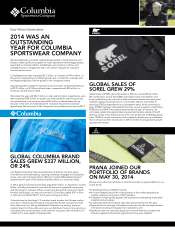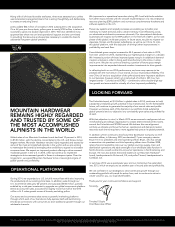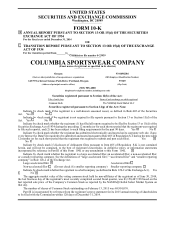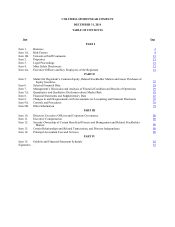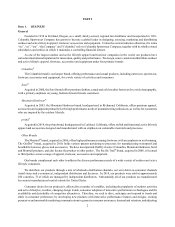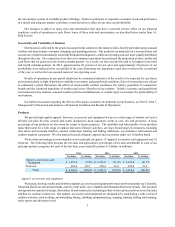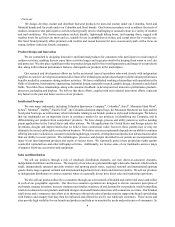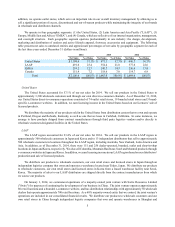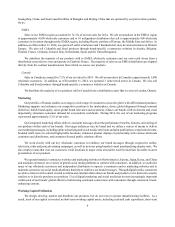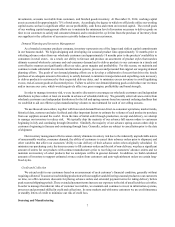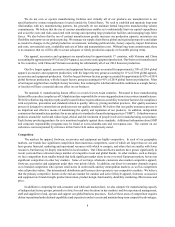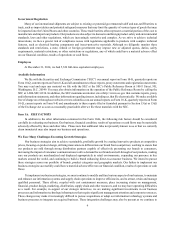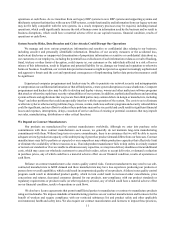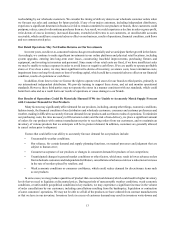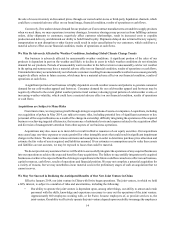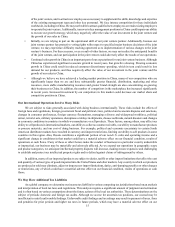Columbia Sportswear 2014 Annual Report Download - page 11
Download and view the complete annual report
Please find page 11 of the 2014 Columbia Sportswear annual report below. You can navigate through the pages in the report by either clicking on the pages listed below, or by using the keyword search tool below to find specific information within the annual report.7
investments, accounts receivable from customers, and finished goods inventory. At December 31, 2014, working capital
assets accounted for approximately 71% of total assets. Accordingly, the degree to which we efficiently utilize our working
capital assets can have a significant effect on our profitability, cash flows and return on invested capital. The overall goals
of our working capital management efforts are to maintain the minimum level of inventory necessary to deliver goods on
time to our customers to satisfy end consumer demand, and to minimize the cycle time from the purchase of inventory from
our suppliers to the collection of accounts receivable balances from our customers.
Demand Planning and Inventory Management
As a branded consumer products company, inventory represents one of the largest and riskiest capital commitments
in our business model. We begin designing and developing our seasonal product lines approximately 12 months prior to
soliciting advance orders from our wholesale customers and approximately 18 months prior to the products' availability to
consumers in retail stores. As a result, our ability to forecast and produce an assortment of product styles that matches
ultimate seasonal wholesale customer and end-consumer demand and to deliver products to our customers in a timely and
cost-effective manner can significantly affect our sales, gross margins and profitability. For this reason, we maintain and
continue to make substantial investments in information systems, processes and personnel that support our ongoing demand
planning efforts. The goals of our demand planning efforts are to develop a collaborative forecast that drives the timely
purchase of an adequate amount of inventory to satisfy demand, to minimize transportation and expediting costs necessary
to deliver products to customers by their requested delivery dates, and to minimize excess inventory to avoid liquidating
excess, end-of-season goods at discounted prices. Failure to achieve our demand planning goals could reduce our revenues
and/or increase our costs, which would negatively affect our gross margins, profitability and brand strength.
In order to manage inventory risk, we use incentive discounts to encourage our wholesale customers and independent
distributors to place orders at least six months in advance of scheduled delivery. We generally solicit advance orders from
wholesale customers and independent distributors for the fall and spring seasons based on seasonal ordering deadlines that
we establish to aid our efforts to plan manufacturing volumes to meet demand for each of our selling seasons.
We use those advance orders, together with forecasted demand from our direct-to-consumer operations, market trends,
historical data, customer and sales feedback and other important factors to estimate the volumes of each product to purchase
from our suppliers around the world. From the time of initial order through production, receipt and delivery, we attempt
to manage our inventory to reduce risk. We typically ship the majority of our advance fall season orders to customers
beginning in July and continuing through December. Similarly, the majority of our advance spring season orders ship to
customers beginning in January and continuing through June. Generally, orders are subject to cancellation prior to the date
of shipment.
Our inventory management efforts cannot entirely eliminate inventory risk due to the inherently unpredictable nature
of unseasonable weather, consumer demand, the ability of customers to cancel their advance orders prior to shipment, and
other variables that affect our customers’ ability to take delivery of their advance orders when originally scheduled. To
minimize our purchasing costs, the time necessary to fill customer orders and the risk of non-delivery, we place a significant
amount of orders for our products with contract manufacturers prior to receiving our customers’ advance orders and we
maintain an inventory of select products that we anticipate will be in greatest demand. In addition, we build calculated
amounts of inventory to support estimated at-once orders from customers and auto-replenishment orders on certain long-
lived styles.
Credit and Collection
We extend credit to our customers based on an assessment of each customer’s financial condition, generally without
requiring collateral. To assist us in scheduling production with our suppliers and delivering seasonal products to our customers
on time, we offer customers discounts for placing advance orders and extended payment terms for taking delivery before
peak seasonal shipping periods. These extended payment terms increase our exposure to the risk of uncollectable receivables.
In order to manage the inherent risks of customer receivables, we maintain and continue to invest in information systems,
processes and personnel skilled in credit and collections. In some markets and with some customers we use credit insurance
or standby letters of credit to minimize our risk of credit loss.
Sourcing and Manufacturing


